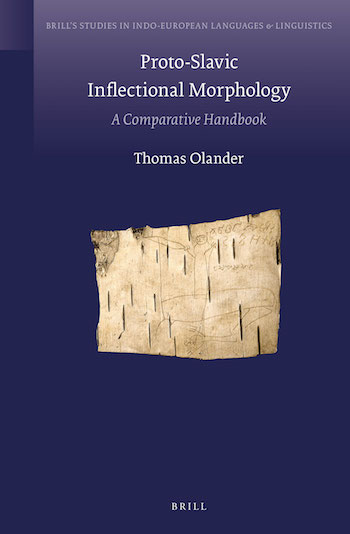Proto-Slavic is the last stage of the language from which all Slavic languages descend. Together with the Baltic languages, Slavic constitutes the Balto-Slavic branch of the Indo-European language family, which also includes branches like Anatolian, Indo-Iranian, Greek, Italic and Germanic.
Proto-Slavic, like Proto-Balto-Slavic and Proto-Indo-European, is not attested itself but reconstructed through historical-comparative linguistic analysis. Proto-Slavic is primarily reconstructed backwards in time, on the basis of the attested Slavic languages. A comparison with the evidence from Baltic and the other Indo-European languages also leads to a secondary reconstruction process forward in time. In terms of absolute chronology, the Slavic languages are attested from around 1000 AD onwards. Proto-Slavic was probably spoken around 600 AD, Proto-Balto-Slavic perhaps around 2000–1000 BC, and Proto-Indo-European around 3500 BC.
The book is an attempt at a reconstruction of the inflectional endings of Proto-Slavic. It systematically covers the inflectional endings of both the Proto-Slavic nominal system – nouns and pronouns – and the verbal system.
Chapter 1 contains the introduction with methodological considerations and clarifications of terminological and definitional problems. In Chapter 2 the Proto-Slavic phonological system is presented and the relevant phonological developments from Proto-Indo-European to Proto-Slavic are examined. Chapters 3 and 4 consist of a systematic exposition of the Proto-Slavic nominal and verbal inflectional endings, accompanied by a diachronic analysis of the Proto-Indo-European, Proto-Balto-Slavic and Proto-Slavic reconstructions. The book is rounded off by the concluding remarks in Chapter 5.
The study differs from almost all other systematic treatments of the Proto-Slavic inflectional system by taking its point of departure in Proto-Slavic proper as it was spoken around 600 AD, not in Common Slavic which includes many later changes common to most or all Slavic dialects. Because of the massive phonological developments that took place in the transition between Proto-Slavic and Common Slavic, the change of perspective undertaken in this study leads to several new analyses of the material. Moreover, unlike other studies with a similar scope, this study takes into account the evidence from the birch bark letters that have been excavated in the Novgorod area from around 1950.
